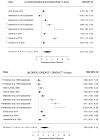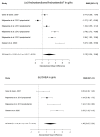Hyperandrogenism? Increased 17, 20-Lyase Activity? A Metanalysis and Systematic Review of Altered Androgens in Boys and Girls with Autism
- PMID: 34830216
- PMCID: PMC8620117
- DOI: 10.3390/ijms222212324
Hyperandrogenism? Increased 17, 20-Lyase Activity? A Metanalysis and Systematic Review of Altered Androgens in Boys and Girls with Autism
Abstract
Introduction: There is increasing evidence that steroid hormone levels and, especially, androgen levels are elevated in autism. An overactivity of 17, 20-lyase with a higher production of the testosterone precursors dehydroepiandrosterone (DHEA) and androstenedione/androstenediol seems especially present in autism. Methods: An encompassing literature analysis was performed, searching for altered androgens in children with autism and using preferred reporting items for systematic reviews and meta-analysis (PRISMA) guidelines. Included were all studies published before 31 March 2021 found using the following electronic databases: PubMed, Google Scholar, Cochrane Library, Scopus, and TRIP. Eight studies with boys and three studies with girls where steroid hormone measurements were performed from either plasma, urine, or saliva were found and analyzed. Analyses were performed for DHEA(-S/-C), androstenedione/androstenediol, and testosterone. Effect sizes were calculated for each parameter between mean concentrations for children with autism versus healthy controls. Results: Higher levels of androgens in autism were detected, with the majority of calculated effect sizes being larger than one. Conclusions: We found higher levels of the main testosterone precursors DHEA, androstenedione, and androstenediol, likely causing an additionally higher level of testosterone, and an increased 17, 20-lyase activity is therefore implied. Medications already used in PCOS such as metformin might be considered to treat hyperandrogenism in autism following further research.
Keywords: androgens; extreme male brain theory of autism; steroid hormones.
Conflict of interest statement
The authors declare no conflict of interest.
Figures








Similar articles
-
Comparison of the efficacy of different androgens measured by LC-MS/MS in representing hyperandrogenemia and an evaluation of adrenal-origin androgens with a dexamethasone suppression test in patients with PCOS.J Ovarian Res. 2021 Feb 14;14(1):32. doi: 10.1186/s13048-021-00781-5. J Ovarian Res. 2021. PMID: 33583431 Free PMC article.
-
Evaluation of Hyperandrogenism in Children with Autism Spectrum Disorder.Indian J Pediatr. 2022 Jul;89(7):717-719. doi: 10.1007/s12098-022-04080-9. Epub 2022 Jan 28. Indian J Pediatr. 2022. PMID: 35089488
-
Androgen dependence of hirsutism, acne, and alopecia in women: retrospective analysis of 228 patients investigated for hyperandrogenism.Medicine (Baltimore). 2009 Jan;88(1):32-45. doi: 10.1097/md.0b013e3181946a2c. Medicine (Baltimore). 2009. PMID: 19352298
-
Androgen levels in autism spectrum disorders: a systematic review and meta-analysis.Front Endocrinol (Lausanne). 2024 May 8;15:1371148. doi: 10.3389/fendo.2024.1371148. eCollection 2024. Front Endocrinol (Lausanne). 2024. PMID: 38779452 Free PMC article.
-
Serum androgen profiles in women with premature ovarian insufficiency: a systematic review and meta-analysis.Menopause. 2019 Jan;26(1):78-93. doi: 10.1097/GME.0000000000001161. Menopause. 2019. PMID: 29994966 Free PMC article.
Cited by
-
Metformin Improves Burn Wound Healing by Modulating Microenvironmental Fibroblasts and Macrophages.Cells. 2022 Dec 16;11(24):4094. doi: 10.3390/cells11244094. Cells. 2022. PMID: 36552856 Free PMC article.
-
Coordinated changes in sensorimotor integration underlie behavioral change through evolution and plasticity: A case study in weakly electric mormyrid fish.Sci Prog. 2024 Jul-Sep;107(3):368504241269438. doi: 10.1177/00368504241269438. Sci Prog. 2024. PMID: 39106354 Free PMC article. No abstract available.
-
Analysis of salivary steroid hormones in boys with autism spectrum disorder.BMC Psychiatry. 2023 Feb 14;23(1):105. doi: 10.1186/s12888-023-04586-2. BMC Psychiatry. 2023. PMID: 36788524 Free PMC article.
-
Light in the Rational Treatment of Autism? Effects of Metformin on Steroid Hormones in a Patient with Polycystic Ovarian Syndrome (PCOS).Life (Basel). 2022 Oct 28;12(11):1736. doi: 10.3390/life12111736. Life (Basel). 2022. PMID: 36362891 Free PMC article.
-
Are steroid hormones and autistic traits affected by metformin? First insights from a pilot.Compr Psychoneuroendocrinol. 2023 Jul 29;16:100196. doi: 10.1016/j.cpnec.2023.100196. eCollection 2023 Nov. Compr Psychoneuroendocrinol. 2023. PMID: 37577184 Free PMC article.
References
-
- Asperger H. Die “Autistischen Psychopathen” im Kindesalter. Arch. Psychiatr. Nervenkrankh. 1944;117:76–136. doi: 10.1007/BF01837709. - DOI
-
- Gasser B.A. The Case of Hellmuth in The Autistic Psychopathy—Suffering from Cushing Syndrome? Glob. J. Intellect. Dev. Disabil. 2018;4:555643. doi: 10.19080/GJIDD.2018.04.555643. - DOI
Publication types
MeSH terms
Substances
Grants and funding
LinkOut - more resources
Full Text Sources
Medical

